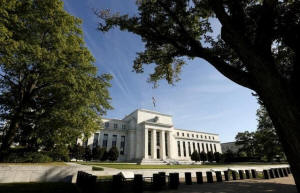Stress test results signal more flexible new-look Fed
 Send a link to a friend
Send a link to a friend
 [June 30, 2018]
By Michelle Price and Imani Moise [June 30, 2018]
By Michelle Price and Imani Moise
WASHINGTON (Reuters) - This year's Federal
Reserve stress test results suggested a more flexible approach, a
further sign the regulator's new leadership is responding positively to
a Wall Street push for pragmatic bank supervision, analysts and lawyers
said.
Banks that took a one-off capital hit due to the 2017 U.S. tax overhaul
got a conditional pass, a departure from the Fed's traditional strict
pass-fail approach to quantitative capital issues, while scandal-plagued
Wells Fargo & Co was able to double share buyback plans.
Goldman Sachs and Morgan Stanley were dinged since their capital fell
below the Fed's minimum, but the regulator's response this year sounded
a more industry-friendly tone under Chairman Jerome Powell and Vice
Chairman Randal Quarles, President Donald Trump appointees, analysts and
lawyers said.
"They have allowed firms to pass on the basis there were special
circumstances and applied a level of pragmatism in the way they haven't
in the past. This is the new Fed and it signals to me an early
retirement of this super-strict quantitative test," said Mike Alix,
financial services risk leader at PwC.

The Fed on Thursday approved the capital plans of 34 lenders following
the second leg of its annual tests, a process introduced after the
2007-2009 financial crisis to assess banks' capacity to withstand a
severe recession. The U.S. central bank has ramped up its worst-case
scenarios each year.
The U.S. tax code rewrite signed into law in December meant Goldman and
Morgan Stanley's Thursday results were weighed, in part, by changes to
the treatment of past losses on hypothetical tax bills under the Fed's
scenarios.
But since the tax issue was a one-off and capital levels in the system
are high, the Fed felt it was unnecessary to fail the two banks, senior
Fed officials said.
Under the conditional approvals for their capital plans, the two banks
can pay out capital distributions but must keep them in line with
previous years.
Some analysts pointed to the Fed's conditional approval of State Street
Corp's higher dividend even though its counterparty exposures showed
high losses under the scenarios.
"This reinforces how the Federal Reserve was less draconian in how it
reacted to the results," said Cowen Washington Research Group's Jaret
Seiberg in a note.
[to top of second column] |

The Federal Reserve headquarters in Washington, U.S., September 16,
2015. REUTERS/Kevin Lamarque/File Photo

Wells Fargo won approval for the highest payout ratio of the major U.S. banks,
quashing investor concerns it would fail the part of the test measuring
operational controls.
A passing grade could signal clearer skies ahead for Wells Fargo and better
relations with regulators, according to analysts at Evercore Group LLC.
Democratic U.S. Senator Sherrod Brown on Thursday criticized bank payouts to
“wealthy shareholders” and warned the Fed against easing up on how it approaches
the tests.
STRESS BUFFER
Lenders have long complained the stress-test process is too opaque and that the
Fed has been too harsh on firms whose results fall short of models the Fed keeps
secret.
Despite noting the Fed's pragmatic stance on Goldman Sachs and Morgan Stanley,
industry insiders still questioned whether the regulator should have proceeded
with the tough scenarios this year given the short-term adverse tax changes, and
said they want further changes to make the process more transparent.
Powell and Quarles have said they believe stress-testing can be more transparent
and less discretionary, but banks continue to worry that Fed rule-easing may not
go far enough or could inadvertently make life tougher if changes are not finely
tuned.
They point, for example, to the Fed's April proposal to introduce a "stress
capital buffer" that would work in tandem with the stress tests to move the
system away from a strict annual quantitative pass-fail.
In a blog post published on Friday, bank trade group The Clearing House warned
the proposal as written could actually exacerbate their capital planning
challenges by requiring banks to capitalize themselves against stress losses
year-round.
"This year’s results illustrate that capital requirements in the United States
are highly volatile from year to year and that the volatility will be magnified
by ... the stress buffer," they added.
(Reporting by Michelle Price and Imani Moise; Editing by Meredith Mazzilli)
[© 2018 Thomson Reuters. All rights
reserved.] Copyright 2018 Reuters. All rights reserved. This material may not be published,
broadcast, rewritten or redistributed.
Thompson Reuters is solely responsible for this content. |